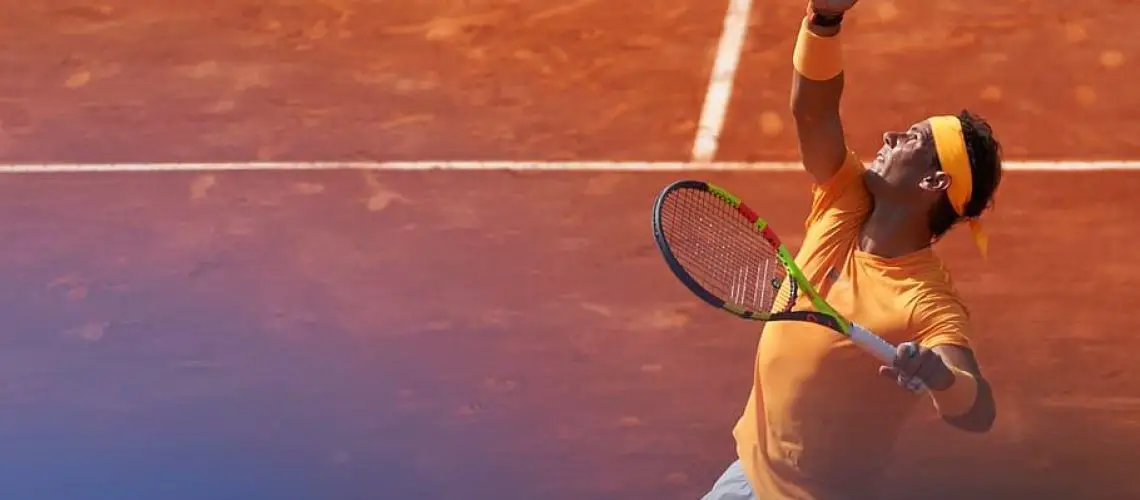We may earn money or products from the companies mentioned in this post.
Brief history of tennis

Tennis, a sport beloved by millions around the world, has a rich and fascinating history that dates back centuries Its origins can be traced to various ancient civilizations, including Egypt, Greece, and Rome However, it was in medieval France that the game we know today as tennis truly began to take shape
During the 12th century, French monks played a primitive version of the game called “jeu de paume,” meaning “game of the palm” It involved hitting a ball with their hands against a wall or over a rope stretched across a courtyard
Over time, rackets were introduced to protect players’ hands from injury The game evolved further in England during the 16th century when it became known as “real tennis” or “royal tennis” This version was played indoors on specially designed courts with complex rules and strategies
Importance of understanding the scoring system

While tennis may seem like a simple game of hitting a ball back and forth over a net, understanding its scoring system is crucial for fully appreciating its intricacies and nuances
1 Enhancing appreciation for the game
By grasping how points are earned and games are won, you can follow along more closely during matches and have a deeper understanding of players’ strategies and performances Knowing when crucial points are being played can add excitement to your viewing experience
Additionally, comprehending how sets and matches are structured allows you to appreciate the mental fortitude required to succeed in this challenging sport Understanding why certain strategies or shot selections are employed can give you newfound respect for the athleticism and skill demonstrated by professional players
2 Improving one’s own gameplay
Understanding the scoring system in tennis is not only beneficial for spectators but also for players themselves By knowing how points are awarded, players can strategize and adapt their game accordingly
For example, understanding that a break point opportunity arises when the server is one point away from losing the game can help a player focus and apply pressure at crucial moments Being aware of advantage points and tiebreakers can also influence a player’s decision-making during tight matches
Moreover, comprehending the scoring system allows players to analyze their own performance more effectively It enables them to identify areas of strength and weakness, track progress over time, and set realistic goals for improvement
In conclusion,
Tennis’s rich history and its unique scoring system contribute to its enduring popularity as both a spectator sport and an active pastime Whether you’re watching or playing, having knowledge of tennis’ origins, evolution, and scoring rules enhances your overall experience So next time you watch a match or step onto the court, take time to appreciate the depth behind this beloved sport
Early Beginnings of Tennis Scoring

Tennis, a popular sport enjoyed by millions around the world, has a rich history that dates back centuries To truly understand the origins of tennis scoring, we must delve into the concept of ‘jeu de paume’ – a French game that laid the foundation for modern tennis
The Concept of ‘Jeu de Paume’
In the medieval era, jeu de paume emerged as a beloved pastime in France Played on a rectangular court with bare hands or gloves, this precursor to tennis captivated players and spectators alike However, there were notable differences between jeu de paume and the tennis we know today
1 French Origins in the Medieval Era
Jeu de paume originated in France during the medieval period, gaining popularity among both nobles and commoners It was played on indoor courts known as ‘salle,’ which were typically designed within royal palaces or prestigious establishments
2 Differences Between Modern Tennis and Jeu de Paume
a) Court Layout and Design:
The court layout for jeu de paume differed from today’s tennis courts Instead of a net dividing it into two halves, jeu de paume featured side walls that players used to keep the ball in play
b) Scoring Methods Used at That Time:
To determine points during gameplay, jeu de paume employed unique methods involving chases, galleries, and dedans targets Points were calculated based on successfully hitting these designated areas with precision
i) Use of Chases, Galleries, and Dedans Targets for Points Calculation:
- Chases: These were areas on the side walls where players aimed to hit the ball, earning them points
- Galleries: Positioned above the chases, galleries served as additional target zones for players to accumulate points
- Dedans Targets: Located at the front of the court, dedans targets provided yet another opportunity for players to score points in jeu de paume
ii) Significance of the Number ’40’ in Eventual Scoring System Adaptation:
Interestingly, jeu de paume’s scoring system played a role in shaping modern tennis scoring The number ’40’ held significance as it represented four consecutive successful hits (15-30-40) required to win a game This adaptation from jeu de paume eventually became an integral part of tennis scoring
Role of Religion in Shaping Early Tennis Scoring Systems
The influence of religion cannot be overlooked when examining early tennis scoring systems In particular, Catholic Church practices had an impact on how scores were calculated and incremented during gameplay
1 Connection to Catholic Church Practices:
a) Division of an Hour into Quarters (Quadrants):
The Catholic Church divided an hour into quarters or quadrants for religious purposes This division served as inspiration for the scoring increments we see in early tennis – 15, 30, and 45 (later reduced to 40).
2 Influence on Scoring Increments: 15, 30, 45 (Later Reduced to 40)
Due to their influence on early tennis scoring systems, these divisions by the Catholic Church led to a unique progression in point increments – starting with 15 points followed by multiples of thirty up until reaching forty The reduction from 45 to 40 points was likely for simplicity and ease of calculation during gameplay
Understanding the early beginnings of tennis scoring unveils a fascinating journey through history From the medieval French game of jeu de paume to the influence of religion on scoring systems, these factors have shaped the sport we know and love today
Tennis Scoring Evolution to Present Day

Transition from jeu de paume to modern lawn tennis
In the journey from the ancient French game of jeu de paume to the modern sport of lawn tennis, one man played a pivotal role – Major Walter Clopton Wingfield In 1873, Wingfield developed a ruleset called Sphairistike, which laid the foundation for the game we know today His efforts were met with enthusiasm, and soon his rules were adopted and standardized across England
Modifications made to simplify the original scoring method
To enhance playability and make scoring more straightforward, several modifications were made to the original scoring method One significant change was reducing the score progression from ’45’ to ’40’. This alteration not only simplified things but also added an element of excitement to matches
Another crucial modification was the introduction of ‘deuce’ as a deciding stage during tied scores When both players reach a score of 40-40 (also known as “deuce”), they must win two consecutive points to secure victory This addition adds tension and suspense to matches, making each point even more crucial
Current popular terminology used in tennis matches
Tennis is known for its unique terminology that has evolved over time Terms like ‘love’, ‘deuce’, and tiebreaker situations are commonly heard during matches today
‘Love’ is used when a player has no points on their side of the scoreboard The origin of this term is still debated among historians, but it adds a touch of whimsy and intrigue to the game
‘Deuce’, as mentioned earlier, comes into play when both players are tied at 40-40 It signifies a critical moment in a match where either player can seize the advantage and move closer to victory
In tiebreaker situations, players engage in a specific game format to break a tied set This allows for a clear winner to be determined when scores are level, often adding an extra layer of intensity and drama to the match
Historical context behind these terms
The origins of tennis terminology can be traced back centuries For example, ‘love’ may have evolved from the French word “l’oeuf,” meaning egg, which symbolizes zero ‘Deuce’ likely comes from the Old French word “deux,” meaning two, representing the need for two consecutive points for victory
Understanding the historical context behind these terms adds depth and richness to our appreciation of the sport It serves as a reminder that tennis is not just a game but a tapestry woven with tradition and intriguing linguistic quirks
Common questions regarding tennis scoring origins

Have you ever wondered why tennis has such an unconventional point system? It’s a question that has puzzled many players and fans alike While there is no definitive answer, several theories have been proposed to shed light on this intriguing aspect of the game
Possible explanations and theories
One theory suggests that the influence of medieval French counting methods may have played a role in shaping tennis scoring During that time, the French used a counting system known as “quatre-vingt” (four twenties), which involved keeping track of numbers in increments of twenty This unique method may have found its way into the scoring system we know today
Another theory connects tennis scoring to religious practices It is believed that the Catholic Church’s influence during the development of modern tennis led to the adoption of an unconventional point system The use of terms like “love,” “deuce,” and “advantage” can be seen as a reflection of religious language and symbolism
Why does ’40’ hold significance in tennis scoring?

The number ’40’ plays a crucial role in tennis scoring, but its origin remains somewhat mysterious Various hypotheses attempt to explain its significance within the game
Exploration of various hypotheses
One hypothesis links ’40’ to jeu de paume, an early form of tennis played without racquets In this game, players aimed at specific targets or chases on the court known as “quarante” (forty). Over time, this term might have made its way into modern tennis as a reference to reaching a significant milestone during gameplay
Another theory suggests that ’40’ was simply chosen for ease of gameplay Compared to traditional numeric scores like 1,2,3, using ’40’ provided a clearer distinction between players and made it easier to keep track of the score during intense matches
What is the origin of ‘love’ in tennis?

The term ‘love’ used to represent a score of zero in tennis has sparked curiosity among enthusiasts for years Several theories attempt to uncover its origin and meaning within the game
Examination of etymology and popular theories
One theory suggests that ‘love’ comes from the French term ‘l’oeuf,’ which means egg or zero The resemblance between the shape of an egg and the number zero may have led to its adoption as a way to denote no points scored
Another theory proposes that ‘love’ reflects the passion and devotion players have for the game Love is often associated with deep emotions and dedication, so using it as a symbol for zero might highlight players’ commitment to their craft
Useful Links

Points are given in tennis 15-30-40. Why 40?
ELI5: where does tennis’ scoring system come from?
In tennis, does anybody know why the scoring goes 15 to …
Where did the tennis scoring system come from?
Mysteries of the Tennis Scoring System – spyn
How to Keep Score in Tennis
Tennis Scoring Simplified | Point System + How To Keep …
The Tennis Scoring System
TENNIS SCORES | MATHCOUNTS Foundation
Can You Decode The Tennis Scoring System?
Tennis scoring, explained: A guide to understanding the …
Where Did Tennis Scoring Come From?
Tennis Scoring 101
The Possible Origins Of The Tennis Scoring System, Part …
Tennis Scoring Made Easy
Tennis Scoring: Points, Sets & Games | Tennis Rules
This is why the scores in tennis are 15, 30 and 40… …
How to Keep Score in Tennis






